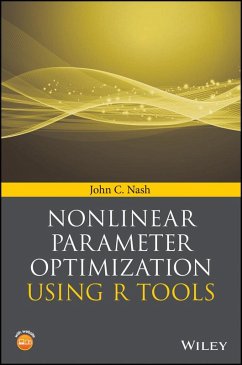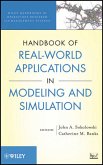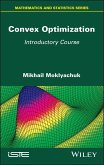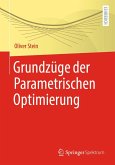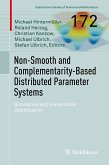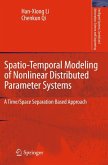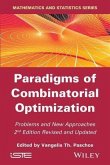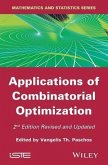Nonlinear Parameter Optimization Using R Tools (eBook, PDF)


Alle Infos zum eBook verschenken

Nonlinear Parameter Optimization Using R Tools (eBook, PDF)
- Format: PDF
- Merkliste
- Auf die Merkliste
- Bewerten Bewerten
- Teilen
- Produkt teilen
- Produkterinnerung
- Produkterinnerung

Hier können Sie sich einloggen

Bitte loggen Sie sich zunächst in Ihr Kundenkonto ein oder registrieren Sie sich bei bücher.de, um das eBook-Abo tolino select nutzen zu können.
Nonlinear Parameter Optimization Using R John C. Nash, Telfer School of Management, University of Ottawa, Canada A systematic and comprehensive treatment of optimization software using R In recent decades, optimization techniques have been streamlined by computational and artificial intelligence methods to analyze more variables, especially under non-linear, multivariable conditions, more quickly than ever before. Optimization is an important tool for decision science and for the analysis of physical systems used in engineering. Nonlinear Parameter Optimization with R explores the principal…mehr
- Geräte: PC
- mit Kopierschutz
- eBook Hilfe
- Größe: 3.52MB
![Handbook of Real-World Applications in Modeling and Simulation (eBook, PDF) Handbook of Real-World Applications in Modeling and Simulation (eBook, PDF)]() Handbook of Real-World Applications in Modeling and Simulation (eBook, PDF)144,99 €
Handbook of Real-World Applications in Modeling and Simulation (eBook, PDF)144,99 €![Convex Optimization (eBook, PDF) Convex Optimization (eBook, PDF)]() Mikhail MoklyachukConvex Optimization (eBook, PDF)156,99 €
Mikhail MoklyachukConvex Optimization (eBook, PDF)156,99 €- -23%11
![Grundzüge der Parametrischen Optimierung (eBook, PDF) Grundzüge der Parametrischen Optimierung (eBook, PDF)]() Oliver SteinGrundzüge der Parametrischen Optimierung (eBook, PDF)22,99 €
Oliver SteinGrundzüge der Parametrischen Optimierung (eBook, PDF)22,99 € ![Non-Smooth and Complementarity-Based Distributed Parameter Systems (eBook, PDF) Non-Smooth and Complementarity-Based Distributed Parameter Systems (eBook, PDF)]() Non-Smooth and Complementarity-Based Distributed Parameter Systems (eBook, PDF)89,95 €
Non-Smooth and Complementarity-Based Distributed Parameter Systems (eBook, PDF)89,95 €![Spatio-Temporal Modeling of Nonlinear Distributed Parameter Systems (eBook, PDF) Spatio-Temporal Modeling of Nonlinear Distributed Parameter Systems (eBook, PDF)]() Han-Xiong LiSpatio-Temporal Modeling of Nonlinear Distributed Parameter Systems (eBook, PDF)40,95 €
Han-Xiong LiSpatio-Temporal Modeling of Nonlinear Distributed Parameter Systems (eBook, PDF)40,95 €![Paradigms of Combinatorial Optimization (eBook, PDF) Paradigms of Combinatorial Optimization (eBook, PDF)]() Paradigms of Combinatorial Optimization (eBook, PDF)267,99 €
Paradigms of Combinatorial Optimization (eBook, PDF)267,99 €![Applications of Combinatorial Optimization (eBook, PDF) Applications of Combinatorial Optimization (eBook, PDF)]() Applications of Combinatorial Optimization (eBook, PDF)159,99 €
Applications of Combinatorial Optimization (eBook, PDF)159,99 €-
-
-
Dieser Download kann aus rechtlichen Gründen nur mit Rechnungsadresse in A, B, BG, CY, CZ, D, DK, EW, E, FIN, F, GR, HR, H, IRL, I, LT, L, LR, M, NL, PL, P, R, S, SLO, SK ausgeliefert werden.
- Produktdetails
- Verlag: John Wiley & Sons
- Seitenzahl: 304
- Erscheinungstermin: 3. April 2014
- Englisch
- ISBN-13: 9781118884751
- Artikelnr.: 40779320
- Verlag: John Wiley & Sons
- Seitenzahl: 304
- Erscheinungstermin: 3. April 2014
- Englisch
- ISBN-13: 9781118884751
- Artikelnr.: 40779320
- Herstellerkennzeichnung Die Herstellerinformationen sind derzeit nicht verfügbar.
1 Optimization problem tasks and how they arise 1
1.1 The general optimization problem 1
1.2 Why the general problem is generally uninteresting 2
1.3 (Non-)Linearity 4
1.4 Objective function properties 4
1.4.1 Sums of squares 4
1.4.2 Minimax approximation 5
1.4.3 Problems with multiple minima 5
1.4.4 Objectives that can only be imprecisely computed 5
1.5 Constraint types 5
1.6 Solving sets of equations 6
1.7 Conditions for optimality 7
1.8 Other classifications 7
References 8
2 Optimization algorithms - an overview 9
2.1 Methods that use the gradient 9
2.2 Newton-like methods 12
2.3 The promise of Newton's method 13
2.4 Caution: convergence versus termination 14
2.5 Difficulties with Newton's method 14
2.6 Least squares: Gauss-Newton methods 15
2.7 Quasi-Newton or variable metric method 17
2.8 Conjugate gradient and related methods 18
2.9 Other gradient methods 19
2.10 Derivative-free methods 19
2.10.1 Numerical approximation of gradients 19
2.10.2 Approximate and descend 19
2.10.3 Heuristic search 20
2.11 Stochastic methods 20
2.12 Constraint-based methods - mathematical programming 21
References 22
3 Software structure and interfaces 25
3.1 Perspective 25
3.2 Issues of choice 26
3.3 Software issues 27
3.4 Specifying the objective and constraints to the optimizer 28
3.5 Communicating exogenous data to problem definition functions 28
3.5.1 Use of "global" data and variables 31
3.6 Masked (temporarily fixed) optimization parameters 32
3.7 Dealing with inadmissible results 33
3.8 Providing derivatives for functions 34
3.9 Derivative approximations when there are constraints 36
3.10 Scaling of parameters and function 36
3.11 Normal ending of computations 36
3.12 Termination tests - abnormal ending 37
3.13 Output to monitor progress of calculations 37
3.14 Output of the optimization results 38
3.15 Controls for the optimizer 38
3.16 Default control settings 39
3.17 Measuring performance 39
3.18 The optimization interface 39
References 40
4 One-parameter root-finding problems 41
4.1 Roots 41
4.2 Equations in one variable 42
4.3 Some examples 42
4.3.1 Exponentially speaking 42
4.3.2 A normal concern 44
4.3.3 Little Polly Nomial 46
4.3.4 A hypothequial question 49
4.4 Approaches to solving 1D root-finding problems 51
4.5 What can go wrong? 52
4.6 Being a smart user of root-finding programs 54
4.7 Conclusions and extensions 54
References 55
5 One-parameter minimization problems 56
5.1 The optimize() function 56
5.2 Using a root-finder 57
5.3 But where is the minimum? 58
5.4 Ideas for 1D minimizers 59
5.5 The line-search subproblem 61
References 62
6 Nonlinear least squares 63
6.1 nls() from package stats 63
6.1.1 A simple example 63
6.1.2 Regression versus least squares 65
6.2 A more difficult case 65
6.3 The structure of the nls() solution 72
6.4 Concerns with nls() 73
6.4.1 Small residuals 74
6.4.2 Robustness - "singular gradient" woes 75
6.4.3 Bounds with nls() 77
6.5 Some ancillary tools for nonlinear least squares 79
6.5.1 Starting values and self-starting problems 79
6.5.2 Converting model expressions to sum-of-squares functions 80
6.5.3 Help for nonlinear regression 80
6.6 Minimizing Rfunctions that compute sums of squares 81
6.7 Choosing an approach 82
6.8 Separable sums of squares problems 86
6.9 Strategies for nonlinear least squares 93
References 93
7 Nonlinear equations 95
7.1 Packages and methods for nonlinear equations 95
7.1.1 BB 96
7.1.2 nleqslv 96
7.1.3 Using nonlinear least squares 96
7.1.4 Using function minimization methods 96
7.2 A simple example to compare approaches 97
7.3 A statistical example 103
References 106
8 Function minimization tools in the base R system 108
8.1 optim() 108
8.2 nlm() 110
8.3 nlminb() 111
8.4 Using the base optimization tools 112
References 114
9 Add-in function minimization packages for R 115
9.1 Package optimx 115
9.1.1 Optimizers in optimx 116
9.1.2 Example use of optimx() 117
9.2 Some other function minimization packages 118
9.2.1 nloptr and nloptwrap 118
9.2.2 trust and trustOptim 119
9.3 Should we replace optim() routines? 121
References 122
10 Calculating and using derivatives 123
10.1 Why and how 123
10.2 Analytic derivatives - by hand 124
10.3 Analytic derivatives - tools 125
10.4 Examples of use of R tools for differentiation 125
10.5 Simple numerical derivatives 127
10.6 Improved numerical derivative approximations 128
10.6.1 The Richardson extrapolation 128
10.6.2 Complex-step derivative approximations 128
10.7 Strategy and tactics for derivatives 129
References 131
11 Bounds constraints 132
11.1 Single bound: use of a logarithmic transformation 132
11.2 Interval bounds: Use of a hyperbolic transformation 133
11.2.1 Example of the tanh transformation 134
11.2.2 A fly in the ointment 134
11.3 Setting the objective large when bounds are violated 135
11.4 An active set approach 136
11.5 Checking bounds 138
11.6 The importance of using bounds intelligently 138
11.6.1 Difficulties in applying bounds constraints 139
11.7 Post-solution information for bounded problems 139
Appendix 11.A Function transfinite 141
References 142
12 Using masks 143
12.1 An example 143
12.2 Specifying the objective 143
12.3 Masks for nonlinear least squares 147
12.4 Other approaches to masks 148
References 148
13 Handling general constraints 149
13.1 Equality constraints 149
13.1.1 Parameter elimination 151
13.1.2 Which parameter to eliminate? 153
13.1.3 Scaling and centering? 154
13.1.4 Nonlinear programming packages 154
13.1.5 Sequential application of an increasing penalty 156
13.2 Sumscale problems 158
13.2.1 Using a projection 162
13.3 Inequality constraints 163
13.4 A perspective on penalty function ideas 167
13.5 Assessment 167
References 168
14 Applications of mathematical programming 169
14.1 Statistical applications of math programming 169
14.2 R packages for math programming 170
14.3 Example problem: L1 regression 171
14.4 Example problem: minimax regression 177
14.5 Nonlinear quantile regression 179
14.6 Polynomial approximation 180
References 183
15 Global optimization and stochastic methods 185
15.1 Panorama of methods 185
15.2 R packages for global and stochastic optimization 186
15.3 An example problem 187
15.3.1 Method SANN from optim() 187
15.3.2 Package GenSA 188
15.3.3 Packages DEoptim and RcppDE 189
15.3.4 Package smco 191
15.3.5 Package soma 192
15.3.6 Package Rmalschains 193
15.3.7 Package rgenoud 193
15.3.8 Package GA 194
15.3.9 Package gaoptim 195
15.4 Multiple starting values 196
References 202
16 Scaling and reparameterization 203
16.1 Why scale or reparameterize? 203
16.2 Formalities of scaling and reparameterization 204
16.3 Hobbs' weed infestation example 205
16.4 The KKT conditions and scaling 210
16.5 Reparameterization of the weeds problem 214
16.6 Scale change across the parameter space 214
16.7 Robustness of methods to starting points 215
16.7.1 Robustness of optimization techniques 218
16.7.2 Robustness of nonlinear least squares methods 220
16.8 Strategies for scaling 222
References 223
17 Finding the right solution 224
17.1 Particular requirements 224
17.1.1 A few integer parameters 225
17.2 Starting values for iterative methods 225
17.3 KKT conditions 226
17.3.1 Unconstrained problems 226
17.3.2 Constrained problems 227
17.4 Search tests 228
References 229
18 Tuning and terminating methods 230
18.1 Timing and profiling 230
18.1.1 rbenchmark 231
18.1.2 microbenchmark 231
18.1.3 Calibrating our timings 232
18.2 Profiling 234
18.2.1 Trying possible improvements 235
18.3 More speedups of R computations 238
18.3.1 Byte-code compiled functions 238
18.3.2 Avoiding loops 238
18.3.3 Package upgrades - an example 239
18.3.4 Specializing codes 241
18.4 External language compiled functions 242
18.4.1 Building an R function using Fortran 244
18.4.2 Summary of Rayleigh quotient timings 246
18.5 Deciding when we are finished 247
18.5.1 Tests for things gone wrong 248
References 249
19 Linking R to external optimization tools 250
19.1 Mechanisms to link R to external software 251
19.1.1 R functions to call external (sub)programs 251
19.1.2 File and system call methods 251
19.1.3 Thin client methods 252
19.2 Prepackaged links to external optimization tools 252
19.2.1 NEOS 252
19.2.2 Automatic Differentiation Model Builder (ADMB) 252
19.2.3 NLopt 253
19.2.4 BUGS and related tools 253
19.3 Strategy for using external tools 253
References 254
20 Differential equation models 255
20.1 The model 255
20.2 Background 256
20.3 The likelihood function 258
20.4 A first try at minimization 258
20.5 Attempts with optimx 259
20.6 Using nonlinear least squares 260
20.7 Commentary 261
Reference 262
21 Miscellaneous nonlinear estimation tools for R 263
21.1 Maximum likelihood 263
21.2 Generalized nonlinear models 266
21.3 Systems of equations 268
21.4 Additional nonlinear least squares tools 268
21.5 Nonnegative least squares 270
21.6 Noisy objective functions 273
21.7 Moving forward 274
References 275
Appendix A R packages used in examples 276
Index 279
1 Optimization problem tasks and how they arise 1
1.1 The general optimization problem 1
1.2 Why the general problem is generally uninteresting 2
1.3 (Non-)Linearity 4
1.4 Objective function properties 4
1.4.1 Sums of squares 4
1.4.2 Minimax approximation 5
1.4.3 Problems with multiple minima 5
1.4.4 Objectives that can only be imprecisely computed 5
1.5 Constraint types 5
1.6 Solving sets of equations 6
1.7 Conditions for optimality 7
1.8 Other classifications 7
References 8
2 Optimization algorithms - an overview 9
2.1 Methods that use the gradient 9
2.2 Newton-like methods 12
2.3 The promise of Newton's method 13
2.4 Caution: convergence versus termination 14
2.5 Difficulties with Newton's method 14
2.6 Least squares: Gauss-Newton methods 15
2.7 Quasi-Newton or variable metric method 17
2.8 Conjugate gradient and related methods 18
2.9 Other gradient methods 19
2.10 Derivative-free methods 19
2.10.1 Numerical approximation of gradients 19
2.10.2 Approximate and descend 19
2.10.3 Heuristic search 20
2.11 Stochastic methods 20
2.12 Constraint-based methods - mathematical programming 21
References 22
3 Software structure and interfaces 25
3.1 Perspective 25
3.2 Issues of choice 26
3.3 Software issues 27
3.4 Specifying the objective and constraints to the optimizer 28
3.5 Communicating exogenous data to problem definition functions 28
3.5.1 Use of "global" data and variables 31
3.6 Masked (temporarily fixed) optimization parameters 32
3.7 Dealing with inadmissible results 33
3.8 Providing derivatives for functions 34
3.9 Derivative approximations when there are constraints 36
3.10 Scaling of parameters and function 36
3.11 Normal ending of computations 36
3.12 Termination tests - abnormal ending 37
3.13 Output to monitor progress of calculations 37
3.14 Output of the optimization results 38
3.15 Controls for the optimizer 38
3.16 Default control settings 39
3.17 Measuring performance 39
3.18 The optimization interface 39
References 40
4 One-parameter root-finding problems 41
4.1 Roots 41
4.2 Equations in one variable 42
4.3 Some examples 42
4.3.1 Exponentially speaking 42
4.3.2 A normal concern 44
4.3.3 Little Polly Nomial 46
4.3.4 A hypothequial question 49
4.4 Approaches to solving 1D root-finding problems 51
4.5 What can go wrong? 52
4.6 Being a smart user of root-finding programs 54
4.7 Conclusions and extensions 54
References 55
5 One-parameter minimization problems 56
5.1 The optimize() function 56
5.2 Using a root-finder 57
5.3 But where is the minimum? 58
5.4 Ideas for 1D minimizers 59
5.5 The line-search subproblem 61
References 62
6 Nonlinear least squares 63
6.1 nls() from package stats 63
6.1.1 A simple example 63
6.1.2 Regression versus least squares 65
6.2 A more difficult case 65
6.3 The structure of the nls() solution 72
6.4 Concerns with nls() 73
6.4.1 Small residuals 74
6.4.2 Robustness - "singular gradient" woes 75
6.4.3 Bounds with nls() 77
6.5 Some ancillary tools for nonlinear least squares 79
6.5.1 Starting values and self-starting problems 79
6.5.2 Converting model expressions to sum-of-squares functions 80
6.5.3 Help for nonlinear regression 80
6.6 Minimizing Rfunctions that compute sums of squares 81
6.7 Choosing an approach 82
6.8 Separable sums of squares problems 86
6.9 Strategies for nonlinear least squares 93
References 93
7 Nonlinear equations 95
7.1 Packages and methods for nonlinear equations 95
7.1.1 BB 96
7.1.2 nleqslv 96
7.1.3 Using nonlinear least squares 96
7.1.4 Using function minimization methods 96
7.2 A simple example to compare approaches 97
7.3 A statistical example 103
References 106
8 Function minimization tools in the base R system 108
8.1 optim() 108
8.2 nlm() 110
8.3 nlminb() 111
8.4 Using the base optimization tools 112
References 114
9 Add-in function minimization packages for R 115
9.1 Package optimx 115
9.1.1 Optimizers in optimx 116
9.1.2 Example use of optimx() 117
9.2 Some other function minimization packages 118
9.2.1 nloptr and nloptwrap 118
9.2.2 trust and trustOptim 119
9.3 Should we replace optim() routines? 121
References 122
10 Calculating and using derivatives 123
10.1 Why and how 123
10.2 Analytic derivatives - by hand 124
10.3 Analytic derivatives - tools 125
10.4 Examples of use of R tools for differentiation 125
10.5 Simple numerical derivatives 127
10.6 Improved numerical derivative approximations 128
10.6.1 The Richardson extrapolation 128
10.6.2 Complex-step derivative approximations 128
10.7 Strategy and tactics for derivatives 129
References 131
11 Bounds constraints 132
11.1 Single bound: use of a logarithmic transformation 132
11.2 Interval bounds: Use of a hyperbolic transformation 133
11.2.1 Example of the tanh transformation 134
11.2.2 A fly in the ointment 134
11.3 Setting the objective large when bounds are violated 135
11.4 An active set approach 136
11.5 Checking bounds 138
11.6 The importance of using bounds intelligently 138
11.6.1 Difficulties in applying bounds constraints 139
11.7 Post-solution information for bounded problems 139
Appendix 11.A Function transfinite 141
References 142
12 Using masks 143
12.1 An example 143
12.2 Specifying the objective 143
12.3 Masks for nonlinear least squares 147
12.4 Other approaches to masks 148
References 148
13 Handling general constraints 149
13.1 Equality constraints 149
13.1.1 Parameter elimination 151
13.1.2 Which parameter to eliminate? 153
13.1.3 Scaling and centering? 154
13.1.4 Nonlinear programming packages 154
13.1.5 Sequential application of an increasing penalty 156
13.2 Sumscale problems 158
13.2.1 Using a projection 162
13.3 Inequality constraints 163
13.4 A perspective on penalty function ideas 167
13.5 Assessment 167
References 168
14 Applications of mathematical programming 169
14.1 Statistical applications of math programming 169
14.2 R packages for math programming 170
14.3 Example problem: L1 regression 171
14.4 Example problem: minimax regression 177
14.5 Nonlinear quantile regression 179
14.6 Polynomial approximation 180
References 183
15 Global optimization and stochastic methods 185
15.1 Panorama of methods 185
15.2 R packages for global and stochastic optimization 186
15.3 An example problem 187
15.3.1 Method SANN from optim() 187
15.3.2 Package GenSA 188
15.3.3 Packages DEoptim and RcppDE 189
15.3.4 Package smco 191
15.3.5 Package soma 192
15.3.6 Package Rmalschains 193
15.3.7 Package rgenoud 193
15.3.8 Package GA 194
15.3.9 Package gaoptim 195
15.4 Multiple starting values 196
References 202
16 Scaling and reparameterization 203
16.1 Why scale or reparameterize? 203
16.2 Formalities of scaling and reparameterization 204
16.3 Hobbs' weed infestation example 205
16.4 The KKT conditions and scaling 210
16.5 Reparameterization of the weeds problem 214
16.6 Scale change across the parameter space 214
16.7 Robustness of methods to starting points 215
16.7.1 Robustness of optimization techniques 218
16.7.2 Robustness of nonlinear least squares methods 220
16.8 Strategies for scaling 222
References 223
17 Finding the right solution 224
17.1 Particular requirements 224
17.1.1 A few integer parameters 225
17.2 Starting values for iterative methods 225
17.3 KKT conditions 226
17.3.1 Unconstrained problems 226
17.3.2 Constrained problems 227
17.4 Search tests 228
References 229
18 Tuning and terminating methods 230
18.1 Timing and profiling 230
18.1.1 rbenchmark 231
18.1.2 microbenchmark 231
18.1.3 Calibrating our timings 232
18.2 Profiling 234
18.2.1 Trying possible improvements 235
18.3 More speedups of R computations 238
18.3.1 Byte-code compiled functions 238
18.3.2 Avoiding loops 238
18.3.3 Package upgrades - an example 239
18.3.4 Specializing codes 241
18.4 External language compiled functions 242
18.4.1 Building an R function using Fortran 244
18.4.2 Summary of Rayleigh quotient timings 246
18.5 Deciding when we are finished 247
18.5.1 Tests for things gone wrong 248
References 249
19 Linking R to external optimization tools 250
19.1 Mechanisms to link R to external software 251
19.1.1 R functions to call external (sub)programs 251
19.1.2 File and system call methods 251
19.1.3 Thin client methods 252
19.2 Prepackaged links to external optimization tools 252
19.2.1 NEOS 252
19.2.2 Automatic Differentiation Model Builder (ADMB) 252
19.2.3 NLopt 253
19.2.4 BUGS and related tools 253
19.3 Strategy for using external tools 253
References 254
20 Differential equation models 255
20.1 The model 255
20.2 Background 256
20.3 The likelihood function 258
20.4 A first try at minimization 258
20.5 Attempts with optimx 259
20.6 Using nonlinear least squares 260
20.7 Commentary 261
Reference 262
21 Miscellaneous nonlinear estimation tools for R 263
21.1 Maximum likelihood 263
21.2 Generalized nonlinear models 266
21.3 Systems of equations 268
21.4 Additional nonlinear least squares tools 268
21.5 Nonnegative least squares 270
21.6 Noisy objective functions 273
21.7 Moving forward 274
References 275
Appendix A R packages used in examples 276
Index 279
